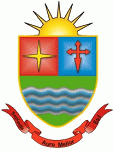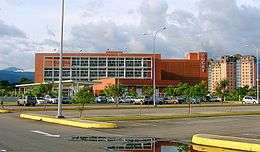Catholic University of Tachira
| Catholic University of Tachira | |
|---|---|
 | |
| Location | |
| Calle Jose Gregorio Hernandez, San Cristóbal, Táchira, Venezuela[1] | |
| Information | |
| Type | Jesuit, Catholic |
| Established | 1962 |
| Rector | Fr. Javier Yonekura Shimizu[2] |
| Staff | 621 professors |
| Enrollment | 4,272 |
| Academics | Wilfredo Rafael González Rodríguez, S.J. |
| Administration | Félida Roa de Roa |
| Website | [ www.ucat.edu.ve UnivTachira] |
 Sabana Larga headquarters of UCAT | |
Catholic University of Tachira (Universidad Católica del Táchira – UCAT) in San Cristobal, capital of Tachira state in Venezuela, originated in 1962 as an extension of Andrés Bello Catholic University of the Society of Jesus.
History
The Catholic University of Tachira is a tertiary education institution born through the initiative of the Diocese of San Cristobal in response to a perceived need for this cultural boost in the Tachira region. It received the support and commitment of the Society of Jesus through Andrés Bello Catholic University, which nine years after its founding was persuaded to open this extension division in Tachira, created by a 1962 resolution of the National Council of Universities. Extension activities began on 22 September 1962. It was the first institution of higher education in Tachira state. In 1982 the extension division became independent from Andres Bello University by decree of the President of the Republic.[3][4]
The newly created University, with the support of the Diocese of San Cristobal, remained under the direction of the Jesuits. It hoped to contribute to enriching the whole of Venezuela, while remaining rooted in the culture of the region. On its jubilee year in 2012 the University was canonically recognized by Pope Benedict XVI.[5]
The headquarters of the Catholic University of Táchira was situated on the old Loma del Tejar and its new University Park in the city of San Cristobal, the state capital of Tachira and center of political, economic, and cultural life of the region. From there, it seeks to train professionals and researchers, gifted humanly and academically, committed to working for a fair, productive, and caring society.[6]
Shield
The gold star in the upper left symbolizes the Immaculate Conception of Mary, patroness of the University. The upper right is from the coat of arms of Bishop Alejandro Fernández Feo-Tinoco under whose initiative the University was founded. Symbolized at the bottom is the Tachira river which forms the Western border of Venezuela and gives its name to the city and university, and the green represents the two lands that border the river. The floating ribbon gives the University's motto nds at sínople, in memory of the sisters lands that serve as banks. Outside the shield and at its base, a floating ribbon gules with the Latin inscription, in gold letters, the motto of the University: Sapientia est auro melior: Wisdom is better than gold. The rising sun with golden rays symbolizes this wisdom. Dr. Aurelio Ferrero Tamayo devised the shield in 1982.[7]
Colleges and schools
The University offers 14 undergraduate and 24 graduate courses.[8]
|
Legal and political sciences
Humanities and education
|
Economics and social sciences
|
Additional programs
There are also departments for postgraduate education,[10] continuing education,[11] virtual education,[12] and research[13] besides a special department of social research.[14]
UCAT cooperates with other Jesuit universities in Latin America[15] to share resources in the following areas: Educational Psychological Counseling, Tax Management, International Economic Relations, Finance, Integral Audit, Culture of Peace and International Humanitarian Law,[16] Prevention of Family Violence, Family Law, and Business Law.
Publications
Paramillo Magazine has been published since 1983 as a multidisciplinary journal covering a wide variety of articles on the research conducted by university students and teachers.
Tachirense Law Journal is an annual founded in 1992 and had 18 volumes through 2013.
Tributum: Revista Venezolana de Ciencias Tributarias is an annual founded in 1996 and deals mainly with public finance & tax law.
Law and Technology Magazine is an annual founded in 2002 emphasizes the impact of technological changes on the field of law.[17]
Service projects
Since 2007 students in their final year are required to perform 120 hours of community service addressed to some social need. Past projects cover a host of different areas such as seminars and clinics on legal issues, health issues, drug use and addiction, agrochemicals, migration, environmentalism, cooperatives, and on the new monetary policies in Venezuela, along with rendering assistance to such organizations as Don Bosco youth center, National Youth Institute, Loma del Viento rehabilitation center, Hippolyta mission, and to various municipalities seeking advice and training.[18]
Activities and sports
Activities include a hiking center, conservation center, and environmental, choral, bagpipes, and theater groups.
Sports include volleyball, soccer, basketball, chess, rugby, softball, aerobics, and swimming.[19]
Student movements have at times met with resistance from the National Guard and Police,[20] as when reports spread of the impending arrest of their student leader.[21] Student protests have been confronted by an armed, pro-government group.[22]
References
- ↑ "Universidad Católica del Táchira, sede Loma del Tejar". Conéctate y Convive. Retrieved 2016-11-27.
- ↑ New rector. Retrieved 2016-11-27
- ↑ No. 1567 dated 26 July 1982, published in Official Gazette extraordinary number 32,524
- ↑ "Universidad Católica del Táchira". www.ucat.edu.ve. Retrieved 2016-11-27.
- ↑ Decree No. 775/1998 of 16 April 2012, through the Congregation for Catholic Education, presided over by Cardinal Zenon Grocholewski
- ↑ Vision. Retrieved 2016-11-27
- ↑ "Universidad Católica del Táchira: Shield". www.ucat.edu.ve. Retrieved 2016-11-27.
- ↑ "Universia.edu: Courses". Universia Venezuela. Retrieved 2016-11-27.
- ↑ "Universidad Católica del Táchira: Faculties & Schools". www.ucat.edu.ve. Retrieved 2016-11-27.
- ↑ "Universidad Católica del Táchira". www.ucat.edu.ve. Retrieved 2016-11-27.
- ↑ "Universidad Católica del Táchira: Continuing Education". www.ucat.edu.ve. Retrieved 2016-11-27.
- ↑ "Universidad Católica del Táchira: Virtual Education". www.ucat.edu.ve. Retrieved 2016-11-27.
- ↑ "Universidad Católica del Táchira: Research". www.ucat.edu.ve. Retrieved 2016-11-27.
- ↑ "Universidad Católica del Táchira: OSET-UCAT". www.ucat.edu.ve. Retrieved 2016-11-27.
- ↑ Rodriguez, Jose D. "Universidad Simón Bolívar Sede Cúcuta - UNISIMÓN FIRMA CONVENIO CON LA UNIVERSIDAD CATÓLICA DEL TÁCHIRA – UCAT". www.unisimoncucuta.edu.co. Retrieved 2016-11-28.
- ↑ Arias, Rina Mazuera; Arias, Neid Albornoz (2010-01-01). "Cultura de Paz un reto de la Universidad Católica del Táchira". Revista ESS (in Spanish). 15 (2).
- ↑ "Universidad Católica del Táchira: Publications". www.ucat.edu.ve. Retrieved 2016-11-27.
- ↑ "Universidad Católica del Táchira: Extension school". www.ucat.edu.ve. Retrieved 2016-11-27.
- ↑ ".:Libro de Oportunidades de Estudios :: OPSU ::". loeu.opsu.gob.ve. Retrieved 2016-11-28.
- ↑ "Universidad Católica del Táchira suspende clases luego de fuerte protesta". El Universal. 2015-01-13. Retrieved 2016-11-28.
- ↑ "Reportan disturbios en la Universidad Católica del Táchira". www.el-nacional.com. Retrieved 2016-11-28.
- ↑ "VIDEO | Grupos armados irrumpen en la Universidad Católica del Táchira". El Estímulo. 2016-11-04. Retrieved 2016-11-28.
Coordinates: 7°47′23.47″N 72°13′37.09″W / 7.7898528°N 72.2269694°W